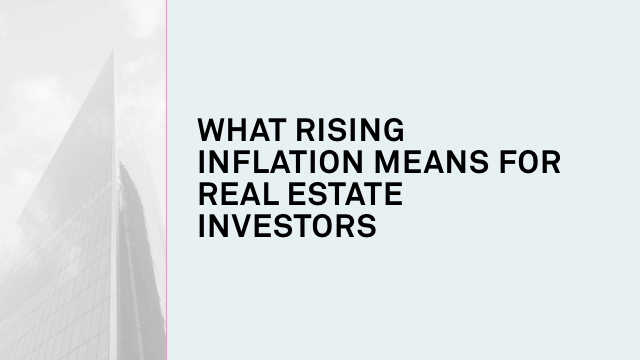Table of Contents
If it seems like the cost of living has increased as of late, you aren’t imagining things. In recent months, the costs for just about all consumer goods and services have risen. Cost for gas, food, utilities, and cars have all risen. These are just some of the goods that are more expensive today than they were at this time last year.
The culprit? Rising inflation.
Over the past year, inflation has increased at the fastest pace since 1982. The consumer price index, which is used to monitor the pace of inflation, has climbed a staggering 6.8% year over year. This is a rate that exceeded what economists had projected.
Investors are keen to monitor inflation. Rapid inflation will surely impact investments of all kinds. Commercial real estate is no different. It too will be impacted by rising inflation.
In this article, we look at how inflation impacts multifamily real estate. This includes its performance during inflationary periods. We will also look at how owners can mitigate the impacts of rising inflation. Read on to learn more.
How is “Inflation” Defined?
Inflation can broadly be defined as a general rise in prices for all consumer goods and services. When inflation rises, consumers’ purchasing power goes down.
There are three primary causes for inflation.
“Cost Push” inflation
The first type is called “cost push” inflation. This is where the costs to businesses rise and are then passed on to consumers. There can be many reasons for these rises, such as if the cost of raw materials (e.g., oil or lumber) get more expensive or if labor costs rise. Another reason for cost push inflation is when there is a shortage of commercial real estate. Therefore, businesses must pay more in terms of rent.
Demand inflation
The second type of inflation is called “demand” inflation. This occurs when there is high demand for certain products and the supply simply cannot keep up. The most common cause of demand inflation is due to people having more discretionary income to spend (a good thing). In this case they are often willing to pay more for certain consumer goods or services.
When inflation increases, the Federal Reserve Bank will generally
start to increase interest rates. When interest rates rise,
the cost of debt correspondingly increases.
Printing more money
The third classic cause of inflation occurs when the government prints more money. The logic is that, by printing more money, the government can boost the economy and create more jobs. The government can quite literally print more notes to bring into circulation. Doing so by increasing government debt, or by letting banks make bigger loans on the same security. In each of these cases, the amount of money in circulation increases. As supply increases, the value of each note eventually decreases (basic laws of supply and demand). In short, there’s more money available, but it doesn’t allow people to buy more. This just drives up prices.
Some degree of inflation can be good for the economy. It becomes problematic when inflation rises too quickly and wages do not keep pace. The harm comes from the fact that costs, prices and wages rarely all rise (or fall) at the same time or rate. This creates a discrepancy that can cause economic disruption.
What is Inflation’s Impact on Multifamily Real Estate?
For the last several years, the rate of inflation has chugged steadily along somewhere between 2% and 3% per year. This allowed multifamily investors to secure incredibly low cost debt. It helped to bolster the apartment industry in the wake of the Great Recession.

During the depths of the COVID pandemic, the Federal Reserve Bank dropped rates even further. This was a way of stimulating the economy and preventing a collapse akin to what we saw back in 2008-2010.
The economy has since stabilized, and today, inflation is rising at rapid speeds.
Rising inflation will have a profound effect on multifamily real estate. Here are some of the ways that inflation impacts the multifamily sector:
Construction costs rise.
In situations caused by cost push inflation, the construction industry generally suffers. This is due to dual factors: as the price for raw materials increases, it makes new construction more cost prohibitive. Meanwhile, if there is a shortage of skilled labor (which is currently the case), contractors must spend more time and resources finding, recruiting and retaining those workers. These shortages, of materials and labor alike, cause construction costs to rise.
This is the situation we’re currently facing.
According to the National Association of Home Builders (NAHB), building material costs soared 26.1% between June 2020 and June 2021. This is the highest percentage cost increase ever recorded in an NAHB survey. The previous record was just 6.1%. This is a record that was set back in 2017. At the same time, the construction worker shortage has reached “crisis levels”. There’s an estimated 740,000 new construction workers needed each year for the next three years to keep pace with demand.
Multifamily inventory diminishes
In some markets, a dramatic uptick in construction costs means that the numbers on a multifamily development no longer pencil out. Simply put, the rents that a developer can achieve are insufficient. Given the high price of new construction, this puts a damper on new multifamily development. Because of this, inventory diminishes.
Multifamily real estate proved to be a darling during the COVID-19 pandemic,
and continues to outperform other real estate asset classes today
as the economy stabilizes and inflation rises.
By some estimates, approximately 400,000 to 500,000 new apartments must be built each year to keep pace with household formation. The U.S. is building nowhere near that amount each year. This is largely exacerbated by a lack of skilled workers.
Prices escalate
In an inflationary environment, the price of multifamily real estate tends to escalate. This is true amongst both new construction and existing assets. As the costs to build increase, developers have no choice but to charge more for those newly constructed assets. Meanwhile, as multifamily inventory diminishes, the price for existing assets increases. With fewer apartment buildings available to purchase, investors will often go toe to toe with each other. This can drive up the price of multifamily assets in the process.
Debt becomes more expensive.
As noted above, when inflation increases, the Federal Reserve Bank will generally start to increase interest rates. When interest rates rise, the cost of debt correspondingly increases. For the last several years real estate investors have benefitted from low cost, fixed rate debt in the +/- 3.0% to 3.85% range.
Low cost debt makes it more affordable for investors to buy multifamily real estate. This can inadvertently drive up the price of apartment buildings. Investors can get more “bang for their buck” when interest rates are low. It can also make it more affordable to finance improvements to the property. This then adds value to the asset.
In an inflationary environment, debt can become substantially more expensive. If interest rates rise by a few hundred basis points or more, the cost of acquiring multifamily real estate and/or making improvements to those properties will also increase.
Investors retreat
As costs rise, some investors will simply retreat to the sidelines. How this impacts multifamily real estate remains to be seen. On one hand, there remains limited inventory, pent up demand, and many investors ready to deploy capital into multifamily real estate. On the other hand, some investors will decide that now is not the right time to invest given price escalations. This could have somewhat of a cooling effect on the market, at least in the short term. However, given the sector’s strong underlying fundamentals, others will view this as an opportunity to grow their portfolios.
What is Multifamily Performance Like During Times of Inflation?
A recent, in depth analysis by U.S. real estate firm Berkadia finds that nearly all commercial real estate product types tend to respond favorably during inflationary periods.
Below is a snapshot of this analysis:
- 0-2%
- 2-5%
- >5%
Multifamily Performance During Times of Inflation
Berkadia looked at various scenarios in which inflation increased by either 0% to2% (pink bars), 2% to 5% (light grey bars) or more than 5% (dark grey bars).
As reflected above, privately owned apartment buildings outperformed all other commercial real estate asset classes during periods of extreme inflation (greater than 5%).
Berkadia also benchmarked privately owned multifamily properties against the stock market and U.S. equity apartment REITs. The study “debunked the idea that stock and REIT returns react positively to rising inflation: Post [Global Financial Crisis], higher inflation meant poor returns in both asset classes.”
To that end, the analysis found that post Global Financial Crisis, a 1% rise in inflation implies a 1.20% rise in private CRE excess returns. Over the same period, a 1% rise in inflation implies a decline in the returns of REITs and stocks. Compared to apartment REITs, U.S. private apartments have a significantly higher average risk adjusted return.
Investors looking to hedge against rising prices
will certainly want to consider adding
apartment buildings to their portfolios.
Hedge against inflation
In other words, for real estate investors looking to hedge against inflation, they are better off investing in multifamily apartment buildings than they are in traditional stocks or REITs. This is especially true during periods of extreme inflation. This is when apartment buildings dramatically outperform any other privately held commercial real estate asset class.
How can Apartment Owners Can Mitigate the Impacts of Rising Inflation?
Increasing annual rents by the annual rate of inflation
One benefit to owning multifamily real estate is that lease agreements are generally no longer than 12 months long. As units turn over, landlords can increase the rent for those units by at least as much as the annual rate of inflation. This may be more difficult to do with lease renewal (or at a minimum, might create sticker shock for existing tenants). As prices for all other consumer goods and services increases, tenants should be prepared for their rents to increase as well.
Re-writing all new leases to tie rental increases to CPI increases
Along those same lines, the owners of multifamily real estate may want to consider re-writing all of their leases to explicitly state that annual rent increases will be no less than the annual change in the Consumer Price Index (CPI). CPI is the primary benchmark for inflation. These clauses were common in rental agreements during the 1970s and 80s. As inflation came down, these clauses began to disappear. This will help prevent the sticker shock mentioned above. It will provide a good baseline for owners looking to justify any seemingly steep increase in rental rates moving forward.
It’s worth noting that in communities that have adopted rent control policies, most landlords are already allowed to increase rents by at least the same amount as annual CPI increases. This is a practice that is widely accepted by many in the housing community.
Renegotiating contracts with vendors
As inflation pushes the costs of all goods and services upwards, it behooves multifamily owners to renegotiate their contracts with vendors. By locking in prices now for at least the next 1-3 years, investors will be able to hedge against further cost escalations. They also benefit from the predictability that this provides. For example, an owner considering a major capital improvement at their property may want to negotiate the contract and pricing now. Even if that work is not slated to begin for some time.
Looking to shift operating costs to residents where feasible
Utility costs have skyrocketed over the past 12 months. To the extent that these costs can be passed on to tenants, landlords should look to do so. This may require an upfront cost (e.g., separating out utilities). Over the long term, having separately metered utilities will ensure any costs in water, electricity, gas, etc. is borne by the tenants instead of the ownership group.
Locking in low cost debt while it’s still available
Interest rates may be on the rise. They’re still hovering near historic lows. Investors who have not yet done so will want to consider locking in long term, fixed rate debt at today’s interest rates before they inevitably rise.
Conclusion
Multifamily real estate proved to be a darling during the COVID-19 pandemic. Additionally, it continues to outperform other real estate asset classes today as the economy stabilizes and inflation rises. Investors looking to hedge against rising prices will certainly want to consider adding apartment buildings to their portfolios.
Interested in investing in multifamily real estate? Contact us today to learn more about Smartland’s portfolio and our strategy for maximizing value across real estate cycles.
FAQs
How does inflation affect apartment fundamentals?
Inflation can lift nominal rents over time, especially in supply constrained markets. At the same time, it pushes up expenses like payroll, repairs, insurance, and property taxes. Net impact depends on how fast you can grow income relative to costs.
What happens to cap rates when inflation is high?
Cap rates often drift up as interest rates rise, which can pressure values. Assets with strong in place cash flow and room for operational improvements tend to hold up better than deals dependent on aggressive growth assumptions.
Do shorter lease terms help or hurt?
They help you reprice faster. Most apartment leases turn annually, so owners can adjust to rising costs more quickly than assets with multi year leases. The flip side is higher turnover risk if affordability gets tight.
What should sponsors change in underwriting right now?
Use more conservative exit cap rates, higher expense growth, and realistic tax and insurance assumptions. Stress test DSCR and breakeven occupancy, and avoid business plans that rely on big rent jumps without clear drivers.
What debt structure works best when prices are rising?
Fixed rate or hedged floating rate debt can protect cash flow. If using floating, budget for rate caps and ongoing reserves. Watch maturity timing so you’re not forced to refinance during a rate spike.
Where are the opportunities in this environment?
Operations and cost control. Focus on properties where you can improve collections, reduce turnovers, optimize utilities, and execute targeted renovations that justify measured rent increases. Pair that with disciplined expenses and solid resident retention.




